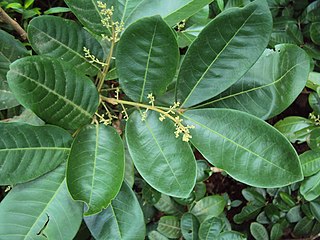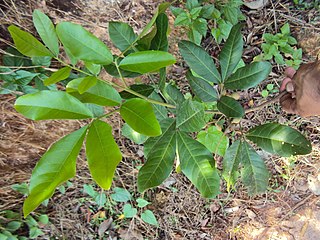
Aglaia is a genus of 117 species of woody dioecious trees belonging to the Mahogany family (Meliaceae). These trees occur in the subtropical and tropical forests of Southeast Asia, Northern Australia and the Pacific.
Aglaia amplexicaulis is a species of tree in the family Meliaceae, endemic to Fiji.
Aglaia apiocarpa is a species of plant in the family Meliaceae. It is found in Southern India and Sri Lanka.
Aglaia archboldiana is a species of plant in the family Meliaceae. It is endemic to Fiji.
Aglaia australiensis is a species of plant in the family Meliaceae. It is endemic to Australia.
Aglaia basiphylla is a species of plants in the family Meliaceae. It is endemic to Fiji.
Aglaia bourdillonii is a species of plant in the family Meliaceae. It is endemic to southern India.
Aglaia brownii is a species of plant in the family Meliaceae. It is found in Australia, West Papua (Indonesia), and Papua New Guinea.
Aglaia cinnamomea is a species of plant in the family Meliaceae. It is found in Papua, Indonesia and Papua New Guinea. Although it was treated as a separate species in a 1998 assessment by the IUCN Red List, other sources include it within Aglaia elliptica.

Aglaia elaeagnoidea, the droopy leaf or priyangu, is a species of plant in the family Meliaceae. It is a 10m tall tree found in American Samoa, Australia, Cambodia, China, India, Indonesia, Malaysia, New Caledonia, Papua New Guinea, the Philippines, Samoa, Sri Lanka, Taiwan, Thailand, Vanuatu, and Vietnam.
Aglaia glabrata is a species of plant in the family Meliaceae. Aglaia glabrata is native to Brunei, Indonesia, and Malaysia.
Aglaia gracilis is a species of plant in the family Meliaceae. It is endemic to Fiji.
Aglaia malabarica is a species of plant in the family Meliaceae. It is endemic to Kerala, India.
Aglaia perviridis is a species of plant in the family Meliaceae. It is found in Bangladesh, Bhutan, China, India, Malaysia, Thailand, and Vietnam.

Aglaia saltatorum is a species of plant in the family Meliaceae. It is found in Fiji, Niue, the Solomon Islands, Tonga, Vanuatu, and Wallis and Futuna Islands.

Aglaia simplicifolia is a species of plant in the family Meliaceae. It is found in Brunei, India, Indonesia, Laos, Malaysia, and Thailand.
Aglaia smithii is a species of plant in the family Meliaceae. It is found in Indonesia and the Philippines.

Aglaia tomentosa is a species of plant in the family Meliaceae. It is found in Australia (Queensland), Brunei, India, Indonesia, Laos, Malaysia, Papua New Guinea, the Philippines, Singapore, and Vietnam.
Helicostylis heterotricha is a species of plant in the family Moraceae. It is endemic to Brazil.

ʻEua National Park is a national park on the island of ʻEua in Tonga. It is the country's only national forest park and covers an area of 4.51 km2 (2 sq mi). The park is located on the east coast of the island and covers an 800 metres (2,625 ft) band of tropical rainforest and is bordered on the west by sheer cliffs to the ocean, which have numerous caves and chasms. It received national park status in 1992. The area is protected by IUCN.






